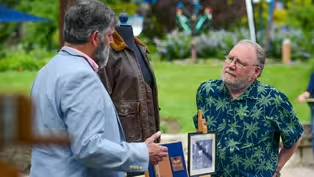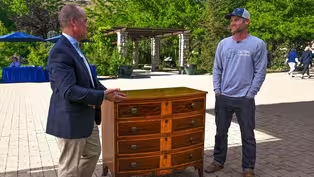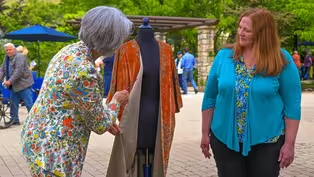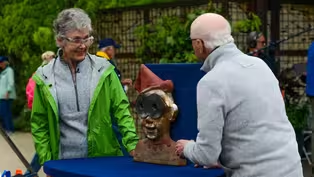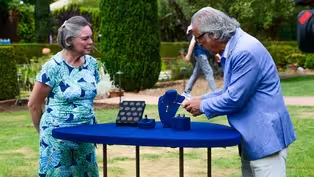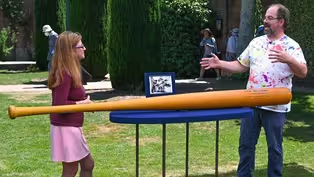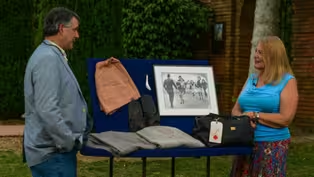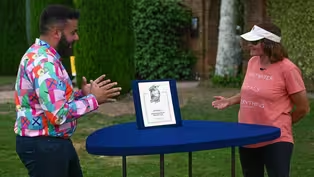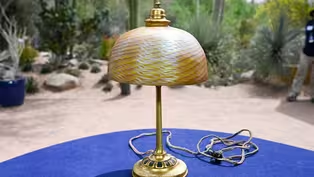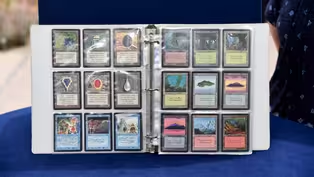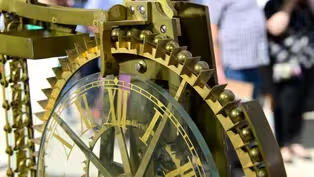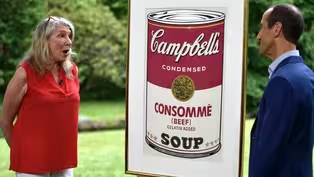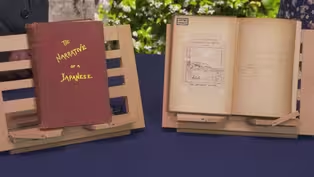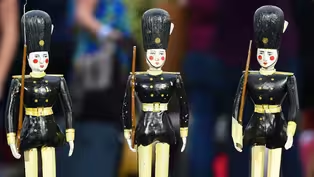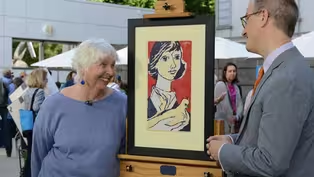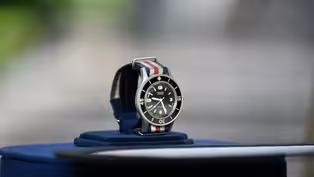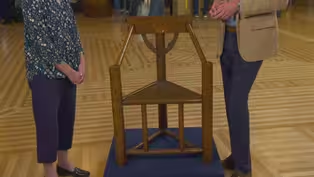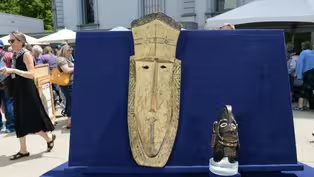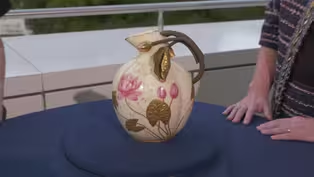
RECUT: Crocker Art Museum, Part 1
Special | 22m 27sVideo has Closed Captions
Head to California’s Crocker Art Museum for a bite-sized RECUT! One find is up to $75,000!
Head to California’s Crocker Art Museum for a bite-sized RECUT, including appraisals like a Coca-Cola neon clock, a Klingenthal violin & bow, ca. 1920, and 1934 Babes in Toyland stop-motion animation soldiers. Which is $50,000-$75,000?
Problems playing video? | Closed Captioning Feedback
Problems playing video? | Closed Captioning Feedback
Funding for ANTIQUES ROADSHOW is provided by Ancestry and American Cruise Lines. Additional funding is provided by public television viewers.

RECUT: Crocker Art Museum, Part 1
Special | 22m 27sVideo has Closed Captions
Head to California’s Crocker Art Museum for a bite-sized RECUT, including appraisals like a Coca-Cola neon clock, a Klingenthal violin & bow, ca. 1920, and 1934 Babes in Toyland stop-motion animation soldiers. Which is $50,000-$75,000?
Problems playing video? | Closed Captioning Feedback
How to Watch Antiques Roadshow
Antiques Roadshow is available to stream on pbs.org and the free PBS App, available on iPhone, Apple TV, Android TV, Android smartphones, Amazon Fire TV, Amazon Fire Tablet, Roku, Samsung Smart TV, and Vizio.
Buy Now
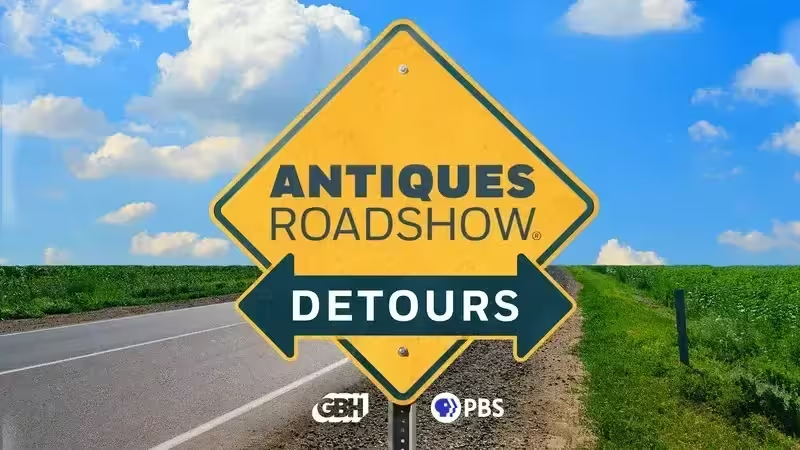
ANTIQUES ROADSHOW DETOURS
Ever wondered what happens to the treasures featured on America’s beloved ANTIQUES ROADSHOW after the cameras leave town? Host Adam Monahan tracks down the juicy afterlives of your favorite finds from PBS’s hit series.Providing Support for PBS.org
Learn Moreabout PBS online sponsorshipMore from This Collection
America’s favorite treasure hunt ANTIQUES ROADSHOW presents a bite-sized way to enjoy the show. ANTIQUES ROADSHOW RECUT features thirty-minute episodes, packed full of favorite finds and paced for maximum entertainment. RECUT features episodes recut from the show’s previous visits to distinctive and historic locations across the country.
RECUT: Idaho Botanical Garden, Part 4
Video has Closed Captions
Wrap up Season 4 of RECUT with a $50,000 appraisal at Idaho Botanical Garden! (22m 31s)
RECUT: Idaho Botanical Garden, Part 3
Video has Closed Captions
Visit the “City of Trees” for unbe-leaf-able Boise treasures in this half-hour RECUT. (22m 31s)
RECUT: Idaho Botanical Garden, Part 2
Video has Closed Captions
In this half-hour RECUT, watch breathtaking Boise appraisals at Idaho Botanical Garden. (22m 31s)
RECUT: Idaho Botanical Garden, Part 1
Video has Closed Captions
Gem State treasures sparkle in this half-hour RECUT at Idaho Botanical Garden! (22m 31s)
Video has Closed Captions
Watch wow-worthy Woodside finds in this half-hour RECUT and learn which is up to $44,000! (22m 24s)
Video has Closed Captions
In this half-hour RECUT episode, golden state treasures shine at Filoli. One is $150,000! (22m 23s)
Video has Closed Captions
Watch fascinating Filoli finds in this half-hour RECUT, including one up to $100,000! (22m 36s)
Video has Closed Captions
This season's first half-hour of RECUT wows our guests with a $200,000 to $330,000 find! (22m 30s)
RECUT: Desert Botanical Garden, Part 2
Video has Closed Captions
Phoenix treasures heat up, like one appraisal up to $35,000, in this half-hour RECUT! (22m 28s)
RECUT: Desert Botanical Garden, Part 1
Video has Closed Captions
Phenomenal Phoenix finds abound in this half-hour RECUT. One is worth up to $100,000! (22m 26s)
RECUT: Crocker Art Museum, Part 2
Video has Closed Captions
See stunning Sacramento finds like one $80,000-$125,000 treasure, in this half-hour RECUT! (22m 28s)
RECUT: Winterthur Museum, Garden & Library, Part 2
Video has Closed Captions
Discover Delaware treasures in this half-hour RECUT, including one valued at $50,000! (22m 27s)
Providing Support for PBS.org
Learn Moreabout PBS online sponsorship♪ ♪ CORAL PEÑA: "Antiques Roadshow: Recut" is fulfilling Californians' dreams at the Crocker Art Museum in Sacramento.
When my mother died, I found this and one other, which unfortunately was eaten by dogs.
Oh my.
♪ ♪ PEÑA: "Antiques Roadshow Recut" has set up at the Crocker Art Museum, a place that's a combination of old and new in both architecture and art.
The Crockers-- Edwin Bryant, called E.B., and his wife Margaret-- were pillars of the Sacramento community in the latter half of the 19th century.
E.B.
amassed a considerable fortune as legal counsel for the Central Pacific Railroad company.
And after he retired, the couple focused on collecting important California and European artworks.
E.B.
died in 1875, and in 1885, Margaret donated the art gallery to the city of Sacramento, much to the public's delight.
Thousands of "Roadshow" fans are delighted to visit the Crocker and show off their treasures.
Take a look.
♪ ♪ Well, this is, uh... what we believe to be ten pandas on silk.
We got it at a estate sale when we were first looking for art for our place.
MAN: How much did you have to pay for it?
$100, yeah.
Yeah, $100.
That's a pretty rare clock, isn't it?
That's a wicked rare clock.
It's actually still moving.
With the decoration, the way the numerals are, it's... Yeah, I know, huh?
We can see the yellow neon in it.
It's psychedelic-looking, you know what I mean?
And it works!
I mean, you can't ask for anything better.
Tells time.
Oh, yeah, for sure.
It's a beautiful clock.
WOMAN: I inherited it from my mother-in-law.
It was a gift to her from a secret admirer that we don't really know who it was.
I had it in my house, and a friend walked in, and I was playing Nerf with my grandson around it, and they said, "I wouldn't do that."
(chuckles) And after that I put it away.
I know it's American Belleek.
American Belleek is a manufacturer in Trenton, New Jersey.
The mark has the word "Belleek."
Uh-huh.
And then the crown and the sword.
Underneath it, "O&B," and those same letters appear here.
The "O&B" stands for Ott & Brewer.
The factory originally started in the middle of the Civil War.
In 1863... Oh, my gosh.
There were three people that came together.
Mm-hmm.
And then Mr.
Brewer joined a few years later.
Two of the other partners dropped out, and by 1871, it was Ott & Brewer.
They were in business together as Ott & Brewer only until 1892.
So that gives a very, very specific timeframe within which this piece had to have been made.
In around 1882, they brought over from Ireland two guys who had been working for the Irish Belleek factory, because those wares were selling extremely well, and they thought, "We're gonna be able to do the same."
So they started a line that they referred to as Belleek.
Mm-hmm.
It's not exactly the same as Irish Belleek, but it was this incredibly thin, very beautiful porcelain body.
Mm-hmm.
Very translucent.
Uh-huh.
And this is completely hand-done and painted.
At auction, I would probably say something like between $1,500 and $2,500.
Oh.
And it's a really, really nice example of its type.
Oh, well, thank you.
Real treat to have you bring it in.
Thank you.
My great-uncle was a steamship captain on this line-- the Dollar Line-- it's out of San Francisco.
And they owned all the mail service, and did all sorts of cool stuff in the '40s, and...
This one was scuttled in the '90s.
No, no, in 1949.
GUEST: My father collected primitive art.
That's, um, more like island mask.
Uh, South Pacific.
It's a ceremonial mask.
This is a Solomon Island canoe prow.
Mm-hmm.
So they would lash this onto the front of their canoe, and that would be for safe travels and for protection of the, the crew on board.
The canoe prow he bought from a dealer.
And I think he paid $450 for that.
Okay.
And this is back, late '60s.
The Mortlock Island mask, I think he paid $2,000, and he purchased that from the Rose Bowl swap meet.
He gave estimates on these from 1999.
On this, he had said $75,000 at that time.
Okay.
And on the mask, I believe that was around $12,000.
Well, first of all, let's do the geography.
We are in the Pacific.
Yup.
And if you look at New Guinea...
Right.
This piece is also in Melanesia and is way to the east of New Guinea.
Mm-hmm.
This is in Micronesia, in the Caroline Islands, which is due north.
Got it.
Of New Guinea.
You can see down here on the edges... Yeah.
and on the nose, the eyes are popped out a little bit, and we have some conditions on the back.
Right.
That in itself does hurt the value a little bit, but it also tells us that it's probably been used.
Right.
So in that sense, it's good.
The same thing on the Solomon Islands.
If you look at the raised surfaces, there is a patina of handling.
Yeah.
This is a decorative prow that's on the front of a fishing or a hunting canoe.
Some of the research indicates that these things could be displayed prominently when they were returning from a hunting party to indicate that everyone was safe.
Got it.
Whether that's true or not, I don't know.
I've done a lot of reproductions on this show.
I can tell you that this is not a reproduction.
Thank you.
Stylistically, the painting is a little bit baroque.
We're looking at a 19th-century mask, somewhere between 1875 and 1900.
The ones that have really sold well, and that is in the six figures...
Right.
Actually are a little bit smaller than this one.
Oh!
This one's 23.
Those are in the 19- to 20-inch range.
Right.
Now, the same thing over here on this piece.
It's a little bit baroque when you look at the hair style on this.
Yeah.
The way the treatment is on the earrings, the raised surface on the top of the ear and the bottom of the ear.
This mask is interesting, because we know that headhunting stopped in the Solomon Islands at the end of the 19th century.
Right.
So clearly, I think the date on this one could be in that same range...
Okay.
Of 1875 to 1900.
This object definitely was used... Mm-hmm.
But it's a later piece.
Right.
So we have to take that into consideration.
Masks from Caroline Islands, specifically Mortlock, are extremely rare.
What do you think the values are on these pieces now?
Starting with my dad's estimate-- that was before 2008, when everything dropped out, but now I know the economy is better, and things are starting to get more collected-- I would expect at least to recapture that level.
I'm gonna give you values based on what I think an auction would be.
This piece here, I would go in, and I would catalogue the Mortlock at $20,000 to $25,000.
Okay.
On this piece, I would go $10,000 to $15,000.
Wow.
Now you should probably insure this for $30,000 to $40,000.
Mm-hmm.
And that one maybe $20,000 to $25,000, Did I answer all your questions?
Okay-- you did, yes.
Do you have any more questions?
Can you make it higher?
When I was a little kid, my parents got it at a yard sale in Chicago.
They were looking for a salt shaker for their brand-new house.
But they saw this there for five dollars and they just had to get it.
And ever since then, it's just been on the wall in our house, and I've just always been curious about it.
Do you know when your parents bought it?
Uh, well, I was about one at the time, so I think, like, '98, '99.
Well, the painting is by an artist named Gertrude Abercrombie.
It's signed and dated, 1945.
Mm-hmm.
Oil on panel.
She is known as a bit of a bohemian artist, a Surrealist, and she worked in Chicago, so...
Okay.
It makes sense that you would find it there.
She also has a lot of associations with jazz.
Dizzy Gillespie actually played at her second wedding.
Oh, wow.
She's known for these Surrealist paintings.
She considered them somewhat of a self-portrait, and we know that, she said that, I'm not making it up.
(both laughing) In this particular painting, we can see the owl.
There's the moon and the cloud.
Mm-hmm.
The cup on the table there, the proverbial witches' brew.
Mm-hmm.
She had trouble with alcohol, as well.
So I, I think we see aspects of her vision of herself as kind of a, a witch, a character outside of the normal.
That's really interesting.
And it's all in a very barren place.
I think at auction, even though it's only four by five inches, we would give it an estimate of $8,000 to $12,000.
Wow, wow.
That... that's a lot.
More than five.
That's... (laughs) I, I would have guessed, like, maybe $35.
Yeah.
Wow.
Her work is quite rare, and it's also on a major upswing.
Her strongest prices are all within the last five years.
Wow!
♪ ♪ PEÑA: The Minton tiles in the entry, vestibule, and staircase landing have held up well over the years.
The Staffordshire, England-based company was a leading pottery and porcelain manufacturer in the 19th century, and was thought to produce some of the best-quality tiles available at the time.
♪ ♪ WOMAN: I brought a watch that I found while thrifting.
And what made you pick out this piece?
It tickled me.
It had heft, it had weight.
Feeling of quality, huh?
Feeling something, and I guess that's what quality feels like.
Yeah.
Uh-huh.
May I ask what you paid for it?
I paid about $100 or so.
This model is the large size of the Blancpain Aqua-Lung.
I would date it about 1961, and it's a diver's watch, of course.
And it was made to go to 1,000 feet in depth, which was extremely deep for this time.
This watch is very complete.
I know you replaced the band.
Very difficult to find, the original rubber straps.
The straps can be worth over $1,000 for a black rubber strap.
Because it's a larger size, it's a very desirable model.
So do you know how much your watch is worth?
12 or 13?
A hundred or a thousand, you're thinking?
Well...
Okay.
(laughs) Well, it would be nice if it were a thousand.
The value I'm giving you is just for the head of the watch.
And a head is a watch without a bracelet or band on it.
This particular model that you have, I think a low estimate would be $25,000.
And I think it more likely would sell between $30,000 and $35,000 at auction today.
Hm.
Oh, my.
That's very nice to know.
Thank you.
Ooh.
(laughs) I'm sorry, I'm trying to compose myself.
Yeah.
Thank you.
(chuckles) It's a really nice one.
You don't want to know where I keep it.
(laughs) No, don't tell anybody where you keep it.
You should lock it up in the bank.
♪ ♪ My grandfather called him Ham Gravy because of the color of his hair.
Okay.
Made my mother very mad.
She thought...
I thought it was a fabulous name for a doll.
JDK211 was the style number of this particular face.
I brought my dad's, um, junior violin.
He took lessons back in 1940, 1938 area.
And it's a... says "Stradivarius" in the, um, center of it, but we're not sure yet.
So my grandfather grew up in Japan... Uh-huh.
And then became a teacher in Japan.
Uh-huh.
He later became a professor at Stanford and I inherited his library.
So these books were published in Yokohama in 1895, and it's two-volume set of a, of a first edition.
Not only are these two volumes extremely rare, they also have an incredible history.
The author, Joseph Heco, was actually the first Japanese-American.
So he was actually found at sea in the 1850s by an American frigate, and brought to San Francisco, and became involved in the Gold Rush, actually, in the 1850s.
He eventually became an American citizen and worked with the California, um, Senator Gwin.
He ended up in Washington, D.C., where he actually met President Lincoln.
He later returned to Japan and worked with Commodore Perry when they opened up Japan to Western influences.
And he published these books about his life in 1895 in Yokohama.
You're saying this is the author?
Yes, that's an inscription from the author.
Not probably to your grandfather... No.
But to someone that he had known.
Yeah.
And that adds an additional level of interest associated with it.
Only three copies of this book have appeared in the auction market for the last 30 years, um, so they're very, very hard to find.
(sniffling) Do you have any sense of the value?
Well, I would say conservatively, that the pair would probably have an auction estimate of $6,000 to $8,000 in today's marketplace, and you probably could have them insured for at least $10,000.
So glad you brought them in.
Thank you so much.
We'll put them either in a museum, or in a safe deposit box.
That sounds like a good plan.
Thank you so much.
Thank you so much.
Thank you.
PEÑA: In the late 19th century, the gallery wasn't only meant for displaying the Crockers' art collection.
It was also used as a gathering place for Sacramentans holding private parties and public events.
Notable visitors of that era included Queen Liliuokalani from Hawaii, President Ulysses S. Grant, and Oscar Wilde, to name a few.
WOMAN: I brought a Wayne Thiebaud silk screen from 1954.
It was a gift.
It's inscribed to my father personally, and spent about 50 years in a linen closet.
When my mother died, I found this and one other, which unfortunately was eaten by dogs.
(appraiser laughs) (laughing): My sister's dogs.
Well, this one survived.
I preferred this one anyway.
I have kind of a thing for birds, and I believe this is his first wife.
I'm not sure-- that's family lore.
It's inscribed, "To Zach," which is my father.
Right.
"One summer of happiness."
Yes.
And my father worked for the Southern Pacific Railroad.
Uh-huh.
And he could adjust his schedule so that he had days free to volunteer at the art show at the old State Fairgrounds.
Right.
So that's how he met many people there.
Including Wayne Thiebaud.
And my mother, unfortunately, was an eccentric decorator who wouldn't allow nails in the wall of our house.
Oh... (laughing): So it was... That makes it hard.
It was never hung.
Okay.
So when she died, I got it, I framed it, and I love it.
Well, it was the perfect piece of artwork to see here in Sacramento because of Wayne Thiebaud's great history.
And Wayne Thiebaud is a fantastic American artist, and he's best known for his impastoed paintings of confectionery and cakes and... Pies.
Pies.
And ice creams.
Yeah, and his views of the hills of San Francisco.
He got his Master of Fine Arts degree at the state college here in Sacramento.
And Wayne Thiebaud, born in 1920, is still living and working.
And this is a very exciting work because it's such an early work, 1954, when he was beginning his career.
He studied lithography and screen prints, and this is a color screen print, or serigraph, it's edition of 22.
I've never seen another example of this print, and it, it's a wonderful image because Wayne Thiebaud is sort of known for his images, as you said, of, of cakes and candy apples.
He's sort of a pop icon of postwar American painting, of that kind of imagery that he made his own.
But this has very kind of a pop feeling, too.
The, the flattened colors, the screen print technique.
Uh-huh.
Reminiscent of Andy Warhol... Mm-hmm.
Early Wayne Thiebauds like this are extremely scarce.
This wonderful early print, I would put at auction at $3,000 to $5,000.
Oh, okay, that's great.
If it had been framed and kept flat, I think, at auction, a conservative estimate would be $6,000 to $9,000.
WOMAN: So Dorothy and Billy Rolls were my grandparents, but I knew my grandmother until she was 93, so she left everything in her show trunk to me.
They're just hard shoes with a piece of wood, and some bolts, that then bolted to the stilts.
Which is pretty typical because, where else are you gonna put your feet?
We brought a folk art carved eagle that we think is a John Haley Bellamy carving.
And we're here to find out if it is or not.
And talking to conservators, I said, "Well, we're trying to get tickets to the Roadshow," and she said, "That would be perfect, and take it there."
So here we are.
WOMAN: My grandfather worked for Hal Roach Studios.
He was kind of second-in-command there.
These are from "Babes in Toyland" with Laurel and Hardy.
And these were the toy soldiers that were done with stop-action.
So it was a 16th of an inch, and then they filmed it in 16th of an inch, and filmed it.
And because my grandfather was involved in this particular part of it, we got ten of them.
And you have five here.
Where are the other five?
Uh, with my nieces.
Ah.
There are actually a couple of different names for the movie.
You...
I think you call it "Babes in Toyland"?
"Babes in Toyland."
"The March of the Wooden Soldiers."
It was changed over the years as Disney picked it up, and it was colorized, and so that was changed again.
But originally, it was a musical.
Disney wanted to pick it up.
And they said it was too expensive to animate.
And so that's when Hal Roach picked it up and decided to do it live-action.
You're so on the money.
Actually, it was an operetta.
Yes.
Done in 1903 by Victor Herbert.
Mm-hmm.
And when Hal Roach bought the rights, he decided to do this, and it was most famously a Laurel and Hardy film.
Yes.
And they're "insert sight gag here," because, of course, the picture of them dressed up as soldiers, as well.
Yes.
There were a lot of special effects done where they're shrinking Laurel and Hardy down to the size of these scale-model soldiers.
Yes.
So it was early days in special effects.
This is a very key moment in film history for this particular type of technology.
While we have examples in very, very early optics in cinema... Mm-hmm.
Of some stop-motion animation as early as the 1890s-- 1897 is one of the first examples.
Right.
What happened the year before this film came out in 1934 is you have a stop-motion animation movie that was all the rage.
"King Kong" jumped the technology of stop-motion animation to the very next level.
So to have a piece that ties into that kind of important historic piece of movie technology so early, also from a Laurel and Hardy film...
Yes.
It's kind of ticking a lot of boxes for me, and I think collectors would be very into them.
Oh, good!
Because it's kind of early days of, of special effects technology, people go crazy for these early pieces.
And then you also have the bugler...
Yes.
Who's different from the rest.
And I think, if you were to have them all together, he might be the favorite, because we know that there's probably fewer of him than there are of the guys with the rifles.
Right, my mother gave away the drummer.
(gasps) I wasn't happy, but he was beautiful.
Yeah, she gave it to one of the people taking care of her.
Have you ever had these appraised?
Uh, once, but I don't think he was too much into it, so he didn't know.
I think he said five of them would be maybe $1,000.
It's somewhat unprecedented to have such rare early pieces.
Mm-hmm.
And to have them in multiples.
Okay.
So if you were to take one of these, and put them in an auction, I would fully expect that they would reach at least $10,000 to $15,000 individually.
(laughs) Wow!
And you have five.
Wow.
So I'm no math wizard, but that's $50,000 to $75,000 for the set.
You're kidding!
That's amazing!
Yeah.
I had no idea whatsoever.
Well, they're going to be taken very good care of.
(laughs) That's with the assumption that you obviously wouldn't take all five and dump them onto the market at one time.
I think the price would hold up if they were slowly leaked onto the market.
PEÑA: And now it's time for the "Roadshow" Feedback Booth.
This is our porthole from the Walt Disney World 20,000 Leagues Under the Sea ride.
And we found out that it's worth $3,000 to $5,000, and that the market's going up.
And also, more importantly, we learned it is stupid heavy.
Finally, at long last, we found out how much this allegedly family heirloom is worth.
It's worth 20,000... Pennies.
And we brought this print that is our friend's.
She got it from her grandparents.
It's a 100-year-old Hawaiian block print.
And they valued it at $12,000.
So we may not be giving it back!
(laughs) The reason I like this poster, is kind of, if you look at, and you go around, you can hypnotize people with it 'cause of the colors.
(laughs) The expert said it was worth about 100 bucks, which is good for me.
And I have my great-great-great-great-aunt's diamond ring, her wedding ring.
And it was about $13,500, so we scored today!
(laughs) I'm 65 years old, when I was 21 years old, I bought this statue because I wanted an antique.
It was my first antique.
I've watched "Antiques Roadshow" for 30 years, and this is making my bucket list!
PEÑA: Thanks for watching.
See you next time on "Antique's Roadshow Recut."
Appraisal: 1895 "The Narrative of a Japanese" Volumes I & II
Video has Closed Captions
Clip: Special | 2m | Appraisal: 1895 "The Narrative of a Japanese" Volumes I & II (2m)
Appraisal: 1934 "Babes in Toyland" Stop-motion Soldiers
Video has Closed Captions
Clip: Special | 3m 18s | Appraisal: 1934 "Babes in Toyland" Stop-motion Soldiers (3m 18s)
Appraisal: 1954 Wayne Thiebaud Screenprint
Video has Closed Captions
Clip: Special | 3m 7s | Appraisal: 1954 Wayne Thiebaud "One Summer of Happiness" Screenprint (3m 7s)
Appraisal: Blancpain "Aqua-Lung" Diver's Watch, ca. 1961
Video has Closed Captions
Clip: Special | 1m 52s | Appraisal: Blancpain "Aqua-Lung" Diver's Watch, ca. 1961 (1m 52s)
Appraisal: Monk's Chair, ca. 1900
Video has Closed Captions
Clip: Special | 1m 2s | Appraisal: Monk's Chair, ca. 1900 (1m 2s)
Appraisal: Mortlock Mask & Solomon Island Prow, ca. 1875
Video has Closed Captions
Clip: Special | 4m 51s | Appraisal: Mortlock Islands Mask & Solomon Islands Canoe Prow (4m 51s)
Appraisal: Ott & Brewer American Belleek Lotus Jug, ca. 1890
Video has Closed Captions
Clip: Special | 2m 21s | Appraisal: Ott & Brewer American Belleek Lotus Jug, ca. 1890 (2m 21s)
Providing Support for PBS.org
Learn Moreabout PBS online sponsorship
- Home and How To

Hit the road in a classic car for a tour through Great Britain with two antiques experts.













Support for PBS provided by:
Funding for ANTIQUES ROADSHOW is provided by Ancestry and American Cruise Lines. Additional funding is provided by public television viewers.


